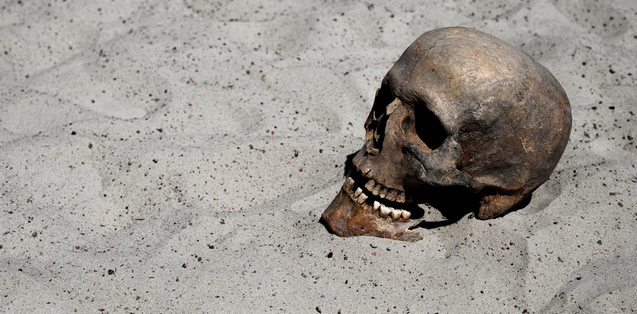According to climate change scientists, we may only have 30 more years before complete environmental catastrophe.
Climate change doesn't seem complicated. Why is it such a divisive issue?
In the past week, the world has experienced chaotic weather phenomena, from deathly Indian heatwaves to snow inundating parts of Queensland. Now, the Breakthrough National Centre for Climate Change has issued a report predicting the end of human civilisation as we know it.
The report, terrifyingly entitled Existential climate-related security risk, glimpses 30 years into the future to the year 2050 — and the results are grim.
Authors David Spratt, a researcher into climate change, and Ian Dunlop, former chairman of the Australian Coal Association and chair of the Australian Greenhouse Office Experts Group on Emissions Trading, propose a scenario in which global emissions and climate threats are ignored, and the trajectory of environmental collapse goes unchecked.
Their conclusions spell out a dire warning.
 |
| Rising temperatures could result in the collapse of Arctic ecosystems. Source: istock |
“More than a billion people may need to be relocated, and in high-end scenarios, the scale of destruction is beyond our capacity to model, with a high likelihood of human civilisation coming to an end,” Spratt and Dunlop warn.
By 2050, total ecological collapse would give way to massive social consequences ranging from “increased religious fervour to outright chaos”.
The report suggests the catastrophic chain of environmental disasters will climax with widespread pandemics, forced migration from inhabitable locations and a likely nuclear war due to skirmishing for limited resources.
“Planetary and human systems (reach) a ‘point of no return’ by mid-century in which the prospect of a largely uninhabitable Earth leads to the breakdown of nations and the international order,” the report predicts.
Spratt and Dunlop sum up our disastrous fate with a harrowing thought: “Climate change now represents a near-to-mid-term existential threat to human civilisation.”
 |
| If the current trajectory of climate change goes unchecked, humankind may face extinction in under a century. Source: AFP |
“David Spratt and Ian Dunlop have laid bare the unvarnished truth about the desperate situation humans, and our planet, are in, painting a disturbing picture of the real possibility that human life on Earth may be on the way to extinction in the most horrible way,” Barrie writes.
The report goes on to analyse each decade, predicting humankind’s downfall on the way to an apocalyptic future.
According to the report, by 2030, policymakers will have failed to act in time to prevent growing greenhouse gas emissions. The current Paris Agreement path indicates failure to build a zero-emission economy that begins accelerated global warming to unprecedented temperatures.
By 2050, sea levels will have risen by 0.5 metres, and 55 per cent of the global population will be subjected to lethal heat conditions for more than 20 days each year. Weather extremes will amplify, including increases in wildfires, heatwaves, drought and the aridification of “more than 30 per cent of the world’s land surface”.
The reality could, however, be catastrophically worse; Spratt and Dunlop suggest the 2050 scenario is “far from an extreme scenario”.
 |
| The climate change report claims almost one third of the world could become an arid wasteland. Source: istock |
In an interview with ABC’s Radio National, Ms Hanson-Young highlighted the importance of circumventing international trade that caused environmental detriment.
“We know that a big part of what Australia is facing is a global problem,” she said. “We can’t deal with the escalation of climate change if we don’t stop making things worse.”
The Greens senator claimed Australian exports, if left unchecked, exacerbated current negative environmental conditions.
“The pollution in the atmosphere doesn’t stop at Australia’s borders. If we export this stuff overseas it’s going to make climate change worse,” she said.
 |
| Greens Senator Sarah Hanson-Young slams current environment laws. Source: Getty Images |
Ms Hanson-Young says this “should” also halt development of any new coal mine projects.
“We’ve got these federal environment laws but they’re so out of date and not fit for purpose that at the moment they don’t even consider the impact of carbon pollution,” she said.
The Greens senator is also pressuring the Federal Government to release emissions data, claiming the undisclosed information may prove pollution from Australia has continued to rise.
Links
- Time To Flick Climate Emergency Switch: A Plea To Our New Parliament
- Climate Change: Australia's Election Has Far-Reaching Consequences
- Australia's Greenhouse Gas Emissions Up For Four Years In A Row
- Climate Index Reveals A Summer Of Record Extremes
- Australia Keeps Voting For Coal, But Investors Are Quietly Abandoning Plans For New Mines
- Australians Could Have Saved Over $1 Billion In Fuel If Car Emissions Standards Were Introduced 3 Years Ago
- The Environmental Aftermath Of Australia's Federal Election
- Rising Seas Threaten Australia’s Major Airports – And It May Be Happening Faster Than We Think
- Australia Plans Coalfield The Size Of Britain In Climate Change U-Turn
- 'We Now Have A Clear Mandate': Coalition Holds The Line On Climate Plan
- Torres Strait Islanders Ask UN To Hold Australia To Account On Climate ‘Human Rights Abuses’
- War On Wind And Renewable Energy Must End
- Morrison Sprints To Adani Approval
- Graphic Design Could Be Holding Back Action On Climate Change – Here’s How
- NSW Towns Including Dubbo And Tamworth Face Water Emergency Within Months
- 'We're Worried The Planet Is Dying': Thousands Of Climate Protesters Bring CBD To Standstill
- Horror 50C heatwave hits 200 million
- 2040: Hope And Action In The Climate Crisis
- Climate change is causing mass ‘die-offs’ in seabirds such as puffins
- Temperature passes 50C Celsius in northern India
- Climate change linked to childhood gastro, according to study



